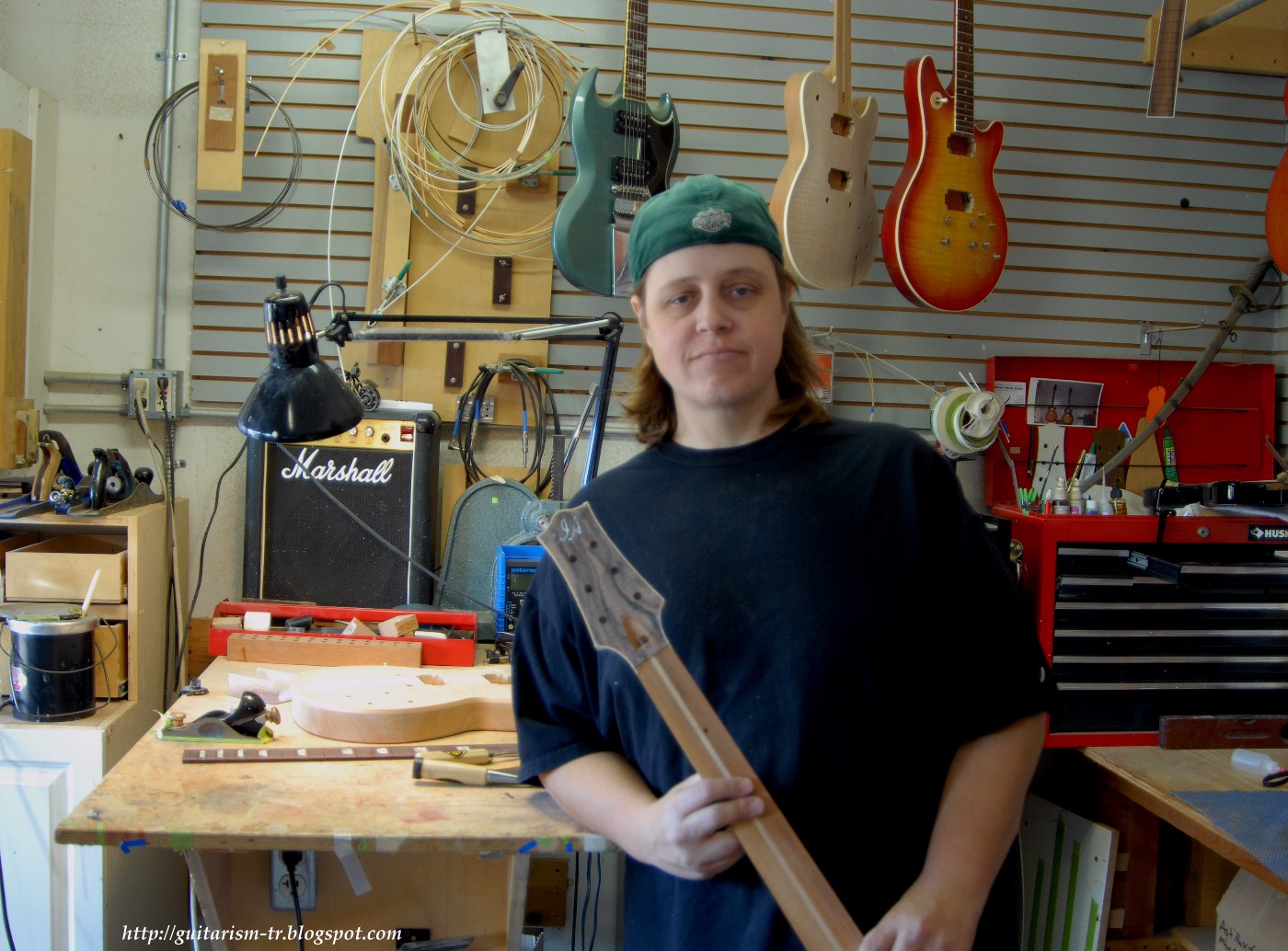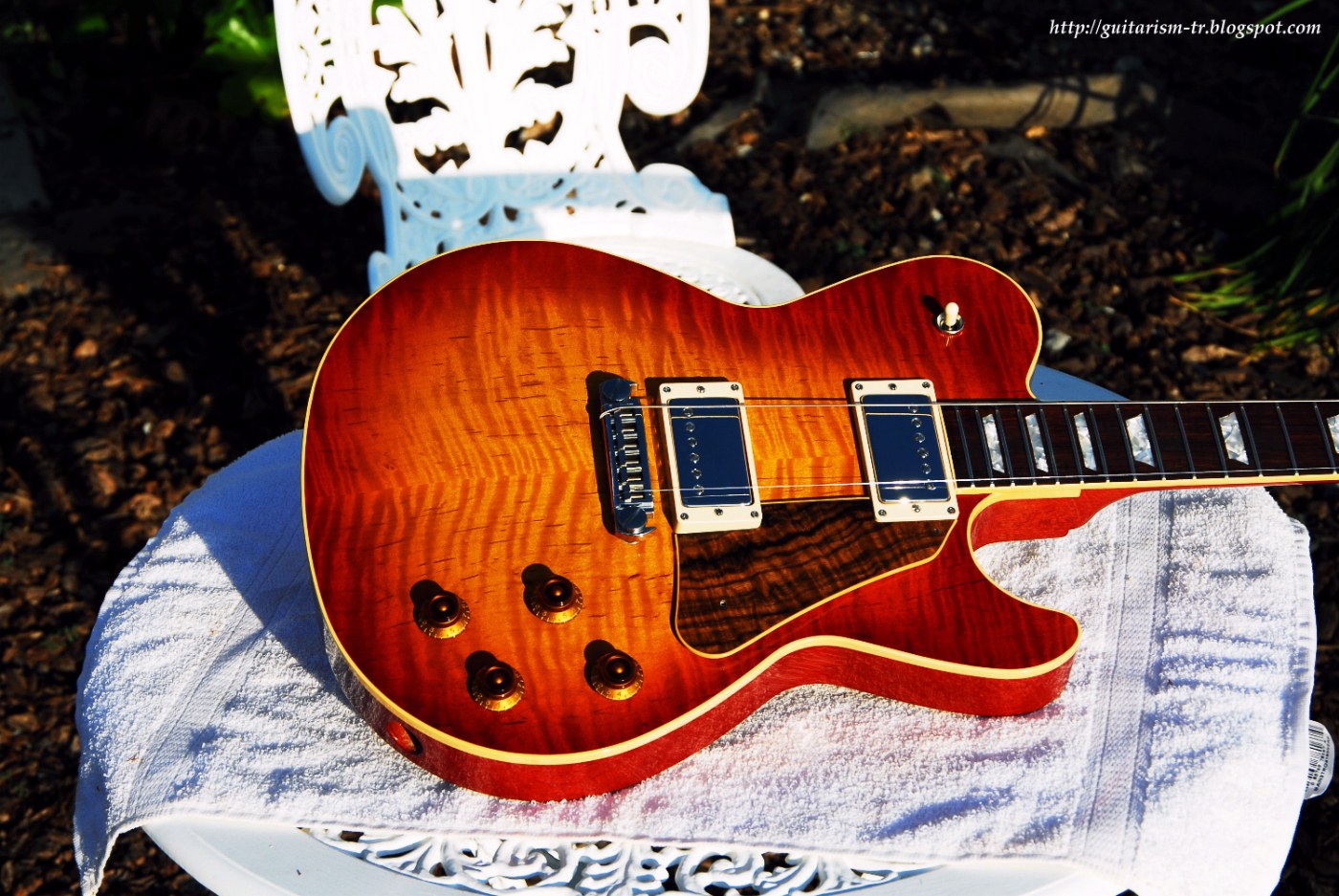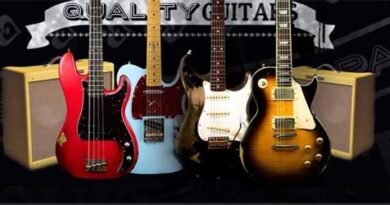Q&A: Ian Anderson of IA Guitars
Ian Anderson interview by Guest Contributor
Q: Hi Ian. It really is a cliche but I think I should ask this. Can you please give us a brief information about yourself?
Thank you! It is a pleasure to do this interview. I have made some wonderful friends in Turkey and it’s an honor to be presented to that audience. First and foremost, I am a music fan. I grew up in the ’70s and ’80s listening to classic rock and roll like Zeppelin, Hendrix, Cream, AC/DC, and some of the current stuff like Van Halen, Malmsteen, Randy Rhoads, et al. That led me back to the blues. The catalyst was when a friend took me to see Stevie Ray Vaughan. Thats would have been in 1984. I wormed my way up to the front row and my life was changed forever. From there it was, John Mayall and the Bluesbreakers, and Robert Johnson. Then it expended into alternative, jazz, classic metal, and just about anything else with good guitar.
Q: Can you tell us the story behind being a guitar builder?
I have been working on guitars almost as long as I have been playing them. I was 14 and had saved up some money, and bought my first guitar. A Kramer inspired by Van Halen. I got it home and admired it for a few minutes. It looked like a pretty simple machine, and I though it would be a lot easier to build one than to play one. So I took it apart to see how it worked! When I put it back together properly I proceeded to learn how to play.
After a few years of building parts guitars, modding, and doing repairs for friends, I met Scott Lentz when looking for someone to paint a guitar body I had built. A lefty strat made from mahogany with a lacewood top and a Floyd Rose. This was in the early ’90s. He painted that guitar and when I asked him to make a neck for my next project he told me to make my own! So that was really a turning point. Over the next 6 or 8 years I built a bunch of strat and les paul inspired stuff. He was a big help and inspiration. In those days, he would paint all my stuff. Until one day when he finally told me to “Paint your own guitars”

A major turning point came in 1990 when I quit my day job and enrolled in a trade school to learn machining. I built a guitar in that class using their CNC software and machinery which won an award. When I got my certificates, I got a job working at Taylor Guitar. Meanwhile, I was working in my shop building guitars, and with Lentz part time. Around ’05 I formally started “Ian Anderson Guitars” and introduced my “Standard” model.
Q: What has Scott Lentz been to you as a builder or restorer or luthier? How deep impact, impression does he has on you? How kind of person or builder would you be if you haven’t met him?
Scott has been a huge influence on me as a builder. The most important thing I learned from him is to have patience! Also, I have always thought you need to know what a great guitar is, to make a great guitar. I am blessed to have been around all the great vintage instruments hat come through the shop for restoration, refinishing, and repairs. Where else are you going to get to take apart a ’50s Les Paul or thoroughly inspect a black guard tele or ’50s strat?
Scott has been around the So Cal. guitar building scene for decades and knew many of the old timers that were at Fender, Rickenbacker in the ’50s to current times. He has shared many wonderful stories, anecdotes, tips and techniques from the old days. He is also knew John Dopera and Grover Jackson, so his roots run deep. It is a real privilege to be witness to that and to carry on the traditions of southern California guitar making.
Q: Two words: “Taylor Guitars” and same question. What do you say?
Taylor is an amazing place full of incredibly talented people. It’s a state of the art facility that is among the best in the world. I learned an incredible amount about guitar building, production, tooling, machinery, fixtures and many of the peripheral aspects of the guitar business. I learned an incredible amount from many great people.


Q: How did you design your standard model form? Do repair and restoration jobs have role or effect on creation?
“The Standard” was inspired by ’50s Les Pauls. The Design came from working on the old guitars and having the appreciation for their classic lines. I wanted to take myself out of the guitar and create something that is timeless and classic. So I drew from a deep well to come up with the Standard. I wanted to build the guitar in the spirit of the originals as closely as possible.
Q: Your model “Standard” reminds Tele in appearance but technically it is much more of a Les Paul type guitar with its wood choice, scale, construction… What are the best aspects, the most significant advantages of your design?
The idea for the Standard model was to have a Les Paul inspired guitar with better ergonomics and fret access. I took the proportions of a Tele which moves the waist back and the upper bout out which gives you more access to the upper frets and sits the guitar on your knee like a Tele. It’s incredibly comfortable to play.
Q: How do you choose woods for certain custom guitar projects? What specifications do you look for a great guitar? And how is your drying/seasoning period of your woods?
My woods are sourced from all over the world. Maple is not maple, and mahogany is not mahogany! Geographical location, along with the species plays a key role in the woods I use. After that is is all about color, grain, weight, and the fundamental tone of the wood. My customers often want a specific look, color or grain pattern, which I try to provide if I can. I build guitars the way I know how with tone being the most important factor.
Q: How long does it take to make a typical “Standard” Ian Anderson guitar? Can you tell us with stages of production?
The typical Standard takes many months to build. Using hide glue I often have to wait a week or more for it to dry and acclimate. The nitrocellulose lacquer process takes up to 3 months depending on the weather. The finish needs to cure for a month before buffing. I like to let the guitar hag out around the shop a bit after it’s been strung up to acclimate to being a guitar and settle in. Using modern urethanes and glues I could cut the whole process down to 2 weeks if I wanted to. This guitar is not intended for the mass market. Nor is it for the faint of heart!


Q: What kind of pickup choices do you get to your customers? Do you wind the pickups by hand yourself or evaluate the best configuration for each guitar, decide which one sounds cool and buy?
For pickups that is up to the customer. I will often use their supplied pickups. And I also work with Wolfetone who has always made me great pickups! I also make my own pickups these days. As a builder I am always searching for more control, and I guess that is why I started building in the first place.


Q: Who are your favorite luthiers, guitar builders?
My favorite modern builders are Scott Lentz, Max, Michael Stevens, Saul Koll, Tom Ribbecke. My favorites from the old days are Gibson, Fender, and National.
Q: It is mostly known that nitrocellulose allows woods keep drying over the years and very suitable for resonating with the wood itself, less vibration absorbing. But some people have clear opposing ideas and according to them those parameters are nothing but a myth. What are your opinions about nitrocellulose lacquers and their most beloved drying and resonating properties?
I don’t use lacquer for the tone, that is really an afterthought. I think an equally thin modern finish will sound as good, in fact I have made some guitars finished in urethane that sound outstanding. So I like lacquer because of it’s organic qualities. I can melt the coats together so the colors will bleed into one another. It has a different look, and over the years will acquire the patina of age.
Time has proven instruments made with timeless classic natural materials are the ones that stand the test of time and have value. In 50 years I want my Standard to look like a vintage Les Paul looks today. My guitar is about feel and vibe, and I think a lacquer finish is a big part of that. Also it is what my customers want and expect. I just like it all around despite the time it takes to do right.


Q: What kind of machine heads do you prefer for Strat/Tele type projects and why? Heavy, sealed or locking ones like Sperzel, Grover etc. or much lighter vintage ones like Kluson, Gotoh etc.?
I prefer the classic vintage Kluson style tuners because of the light weight and vintage vibe. They sound good and reduce the chance of breaking the headstock should a mishap happen. However the modern tuners like the Hipshot or Sperzels have a much improved mechanical feel and action to them that I really like. They can also accentuate a more modern look which can be really cool.
Q: What kind of fixed bridge and metal material type do you like most? Fender type, Gibson LP type tune-o-matic, PRS type wraparound etc.?
Scott Lentz has done a lot of experimenting with bridges and materials which has helped me out. He was good friends with Steve at Pigtail Music who had made his bridges and saddles with various materials. I fgot to try out aluminum and zinc on my standard and they both offer different tones. The ABR1 which is also an option has an influence on the tone. Callaham offers a steel ABR1 which I hear is outstanding and will be trying out in the future. My personal favorite is the intonatable stoptail offered by Pigtail. Tone Pros makes a real nice one as well, however it has to have steel studs and anchors.

Q: What kind of oil or material do you recommend for oiling/cleaning rosewood and ebony fretboards? What do you say about using mineral oils, petroleum oils or baby oils (liquid Vaseline) or using natural plant oils like lemon?
For cleaning and conditioning fretboards and other unfinished hardwoods, I would recommend what we used at Taylor which is bore oil. Bore oil is made to condition the bores of woodwind instruments. Some oils have polyurethane as an ingredient. Some get rancid and will make your guitar stink like dead fish. Others can gum up and plug the wood. Roche Thomas is my preferred brand.
Q: What are your thoughts and experiences with basswood, especially Tilia Americana? Many companies use it on their low budget guitars, so it is known by some as bad tonewood. Actually, for me it may be good choice for some certain needs?
I like basswood and have used in in the past. Since it is so soft It needs a hard finish like polyester resin to add a hard outer shell. I would not use it on a traditional style guitar though. It’s worthy of more experimentation.


Q: What are your opinions about active pickups? You know, many people, including me, don’t prefer them because of lacking overtones, compressed sounds etc.
I like my pickups and electronics to be as simple as possible. The less junk the signal has to go through the better. Active pickups are not my style although they may be for others. I wind vintage style pickups that are as true to what they did back in the day as I can get, and the materials they used as closely as possible.
Q: I’m asking this question to you because everyone may have specific answers for that question and i like to learn yours; What is a good electric guitar for you? What do you expect from a good electric guitar?
A good electric guitar has to have a good tone first. Then a good feel and vibe. It also has to have a classic timeless look. And, be well constructed. Everything has to harmoniously exist from the wood to the colors to the tone and feel.


Q: What do you think about today’s far eastern electric guitars? Korea, China and Indonesia have extremely huge production numbers. Over 4000 guitars are made just in Korea per day (with two huge factories (Cort and Samick) and several small business builders). Can you please give us a general evaluation about standards of those guitars in fret-wise, sound and playability-wise, finish job-wise, quality-wise?
I don’t pay too much attention to those types of guitars. I really don’t know whats going on in that regard. All I do know is they seem to be alot better than they were 20 years ago. I suppose they are good for supplying new and casual players with instruments.
Q: What do you foresee the future of electric guitar? You know, the technology brings many improvements like auto tuning gears, carbon fiber bodies… On the other hand, there is still undeniable group of people desires vintage gears with vintage specs…
The future will always bring new technologies and innovations to the instrument. Which can be interesting and a lot of fun! Anything that engages players is a good thing. However some of us will still slog away on the vintage styled instruments. Classic and timeless instruments made from traditional materials will always be around and desired as time has proven.

Q: What are your opinions about reliced, aged instruments which are very popular these days? Why are people crazy about them?
Aged instruments provide people with a replica of the real thing which is in short supply and expensive. Everybody wants to capture some of the magic. Generally, I am ambivalent towards it. It can be fun, but on my personal guitars I take pride in the honest wear I have put on them from playing!
Q: There are certain periods on electric guitars. 80’s were the years of crazy colors, Floyd Rose, thin necks. If you have dings on your guitar or if your guitar is sunburst, then you weren’t cool. 90’s were transition from “80’s crazy” to “back to the roots” years. 2000’s were kindo weird stuff but vintage type gears gained huge popularity year by year. Today, as former question above, people adore reliced guitars, Fender Custom Shop constantly making relic guitars, released Mexican “Road Worn” models with low budget, so does Gibson and there some small business reliced guitar producers around the world. That’s OK! But what about the next step? What guitar trend will be popular in the next few years?
I think in the future, the guitar will keep splintering off like it has been. From the relics, to vintage guitar mash ups, to smaller builders pushing the boundaries in design and craftsmanship. I think more and more new woods will continue to be used. Some of the vintage type stuff will keep getting better and better. If people keep playing them, they will keep evolving. Also, it is great to see the electric guitar expanding throughout the world. If you told me 20 years ago there would be interest in the type of guitars I am building I would be pleasantly surprised!

Q: You have built a marvelous guitar for a Turkish customer, Demir Uyar a few years ago. Can you summarize the whole process, please. How did he reach you, how did you decide&choose the woods, hardware etc. how was the building period etc.?
Demir is a great friend! It was a pleasure and honor to build a guitar for him. He approached me and to build him a guitar. He is very knowledgeable about guitars, tone and what he wanted, and how to get it. I was really impressed! He is friends with another friend of mine, Can Moray. I am not sure of exactly how he heard about me. You might want to let him embellish the story. Anyway, we started the build. He selected the woods he wanted. He sent me an absolutely stunning piece of Turkish Walnut. It was really cool to use a piece of wood from his country in his guitar. Especially such a beautiful piece.
Demir sent me a pictorial book featuring some of Turkeys historical landmarks. Some of the outstanding photos were of bookmatched stone in the blue mosque which was inspiring considering the bookmatched maple top we used. Demirs created my A’La Turka model in which I use this wood on the pickguard, headstock, and truss rod cover. Overall it was a great experience and I made a great friend in the process.
Q: I know you are familiar to Turkey and made guitars for some people which are incredibly wonderful. Have you ever been here before? Do you know anything about Turkish guitar scene players?
I have never been to Turkey. Demir sent me a great book and some CDs of Turkish music, which I really love. I love to travel and am a big fan of architecture and art. I hope to see it sometime!

Q: Its time for a game. I’m pretty sure you know how w to play. I’ll give you a word and then you will tell us shortly what does it recall firstly:
Les Paul – How High the Moon. Les and Mary ford tearing it up on their Les Pauls.
Stratocaster – 1954 California, the orange groves, country music. A bunch of locals creating a legend in a better time gone by.
Soccer – Hooligans
Lutieria – Guitar building and repairing
Mahogany – Visual recollections of sights and memories of great wood I have worked with.
CNC – digital -vs- analogue
Warren Haynes – Thinking back to the times I have seen him play with Govt. Mule and the Allmans. Hard working great player.
Poplar – Bought some to make a Strat with and used it to make a work bench.
Lynrd Skynyrd – “Play some Skynyrd man” often heard shouted at cover band gigs because of a classic rock comp album that was advertised on television in the ’80s.
Exotic Woods – Makes exotic guitars
CITIES – Govt. Bureaucracy
Chambering – Can cut out entire chunks of the frequency range
NAMM – Lots of fun meet and greet with friends and see all the new gear.
Steve Morse – Dreggs
Endorsement – Big companies paying well known players to play their gear. Part of big business.
A’La Turca burst. My good friend Demir and a killer guitar!
Scott Lentz – The master!
Mineral Stains – Character
Humbucker – Patent applied for tone.
Yngwie – Unleash the fookin fury! Riding my bike in a slushy snow storm 5 miles to get the record the week it came out when I was about 13 or 14 and being totally blown away.
Hide Glue -vs- Titebond – They both have their place.
Amps – My vintage JMI AC30 and ’67 plexi marshall are what I test the guitars with.
Blues – The start of it all.
Family – The love and support to make it all happen.
Crossroads – Robert Johnson standing at the crossroads. I want to travel there to see it one day.
Eric Johnson – Supreme taste and tone. Amazing player.
Ian Anderson Guitars Facebook | Instagram
7 string 16Ω 59 Airbucker Alnico 2 Alnico 4 Alnico 5 Alnico 8 Bare Knuckle BKP Boot Camp Brown Sound Celestion Ceramic Custom Shop David Shepherd DiMarzio Dual Resonance EVH Fishman Floyd Rose Fluence Gibson HSP90 Humbucker Ibanez JB Jimmy Page John Petrucci Les Paul MJ Mojotone P90 PAF Pariah Pickup Satch Seymour Duncan Singlecoil Single Width Speaker Steve Vai Tech Tip Tremolo Virtual Vintage




